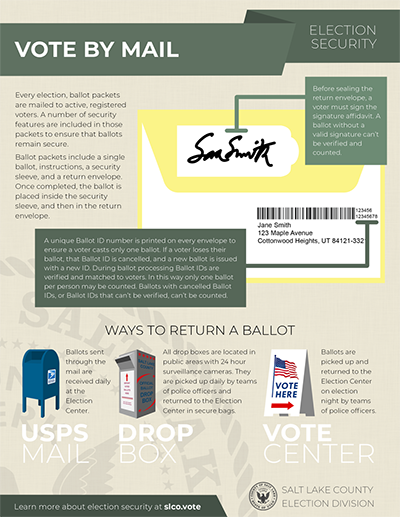Elections
ELECTION SECURITY
VOTE BY MAIL
Because Utah is a vote by mail state every active registered voter is mailed a ballot packet twenty-one days before Election Day. The ballot packet includes a ballot, an instruction sheet, and a return envelope. The envelope has critical security features that ensure that each voter can only vote once per election, and that ballots from outside sources cannot be introduced into an election.

First, every return envelope includes a Ballot ID. The Ballot ID is a unique number generated each election that connects a ballot to an eligible active voter in the statewide database. No two ballots will ever have the same ID number. If a voter loses their ballot, the old Ballot ID is cancelled, and a new ballot is issued with a new Ballot ID. If the old ballot were somehow returned to the Election Center, it would be rejected.
The Ballot ID prevents voters from voting more than once. Once a ballot is returned to the Election Center the Ballot ID is verified against the record of that voter and their vote is logged, making them unable to submit another ballot or vote at an in-person vote center. Alternatively, if a voter votes at an in-person vote center, a notation is made on their voter record so that any ballot submitted with their corresponding Ballot ID will be rejected, making it impossible for them to vote more than once.
The Ballot ID also prevents outside ballots from being introduced into an election. All ballots that are returned to the Election Center are checked against the list of Ballot IDs that were generated for that election. If a ballot is returned with an Ballot ID that isn’t on the list, the ballot is rejected. Or, if a ballot is returned with an Ballot ID that doesn’t match the voter’s ID number, that ballot is rejected. Ballots are only accepted once the Ballot ID has been verified as valid and shown to match the name on the ballot.
The second return envelope security feature is the signature affidavit. Every return envelope has a space for a voter to sign and acknowledge their eligibility to vote. No ballot without a signature can be accepted for counting. Before a returned ballot can be opened, the affidavit signature is scanned and compared to signatures in the voter's database record. If the signature matches, the ballot is then opened and counted. If the signature doesn’t match, and the voter doesn't respond to requests for additional ID verification, the ballot cannot be counted.
Back to Election Security Voter Registration In-Person Voting Ballot Processing
